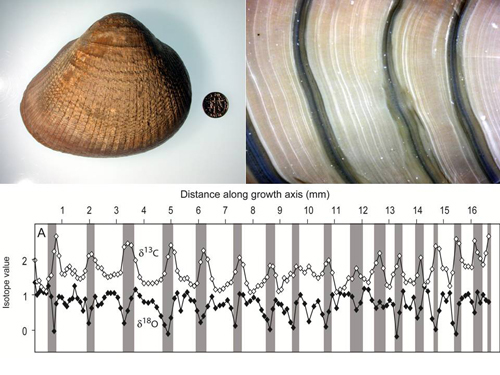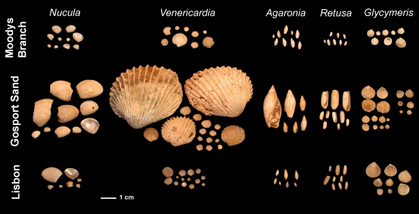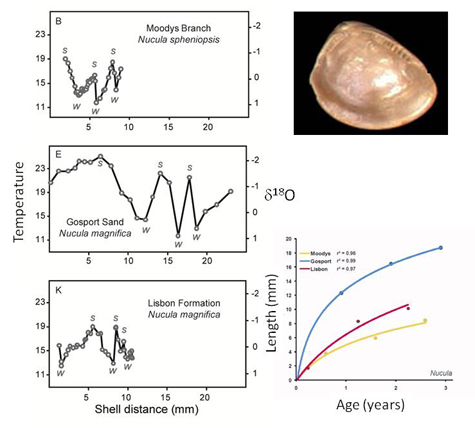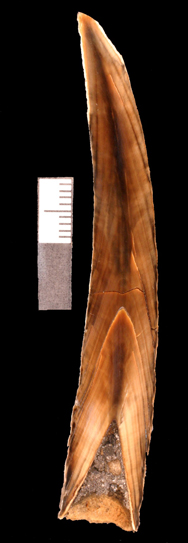Stable Isotopes and Accretionary Skeletons: Growth and Life History
High-resolution microsampled records of stable isotope variation along the growth trajectory of a shell can reveal much about the life histories of ancient organisms and the environments in which they lived, allowing for study of longevity and growth rate through time. Data such as these can contribute to evolutionary studies of heterochrony and shed light on the environmental correlates of growth and longevity.

Why do organisms have the lifespans they do, and why do some species live fantastically long lives in comparison to their close relatives? A number of polar bivalves today exhibit extreme longevity, living upwards of a century or more, while their warmer-water cousins are lucky to make it to 10 years. This phenomenon is often attributed to the cold temperatures of the water in which the clams live, but on Earth today it is impossible to separate this factor from other variables characteristic of polar environments (e.g., long dark winters with little food). Buick and Ivany (2004) examined fossils of the bivalve Cucullaea raea from the Eocene of Antarctica (~45 million years ago), a time when polar latitudes were relatively warm, in order to investigate the relationship between temperature and lifespan in high latitude organisms. High resolution sampling and oxygen isotope analysis of material collected across a portion of two shells reveal seasonal temperature variations during the life of the bivalve, confirm that the Eocene water temperature was warm, and show that dark growth bands in the shell correspond to summertime warm temperatures. The annual nature of these bands then allowed them to count bands and arrive at age estimates for individuals, revealing lifespans on the order of 120 years or more. These polar clams from Earth’s distant past also lived exceedingly long lives, despite living in warm water. The authors suggest that extreme longevity in this case results from slow metabolism associated with the limited light and hence food (phytoplankton) availability that characterizes polar settings. Oxygen and carbon isotope analyses also surprisingly reveal that these clams stopped growing every year during the Austral summer, when sunlight would have stimulated phytoplankton production and presumably shell growth. The researchers suggest that summer growth stoppages reflect the dedication of metabolic energy to spawning at a time when larval survival is more likely due to the presence of food. The small chances for successful reproduction in a generally food-stressed setting may also make long life adaptive, in that there are more opportunities for seasonal spawning.

The Eocene bivalve Cucullaea raea from Seymour Island, Antarctica, and growth bands evident upon cross-sectioning and polishing the shell. Isotope data show these bands to be annual, and growth band counts reveal lifespans of more than 100 years for these fossil bivalves. Photos by Devin Buick, including the cover photo of Geology, above. See Buick and Ivany (2004).

How does body size relate to growth and longevity? Larger shell sizes could result from faster growth or longer lifespan, each of which might imply different causal mechanisms. Body sizes of several common mollusks in the Eocene of the US Gulf Coastal Plain are markedly larger in the middle Eocene Gosport Sand. Micromilled isotope data (see image below) show that shells in the Gosport Sand grew faster than those in adjacent units, likely related to a change in environmental conditions associated with paleoproductivity. See Haveles and Ivany (2010).

Micromilled isotope data for the bivalve Nucula from each of the three formations above, and resulting growth curves showing much faster growth in the Gosport Sand specimen. See Haveles and Ivany (2010).

Cross section through the tooth of a Pliocene sperm whale, Physeterula dubusii, showing annual growth banding. Lifespans of these fossil whales recorded by the bands in their teeth suggest rapid growth to attain the large body size implied by tooth size. Photo and research by Kwasi Gilbert.
Collaborators
- Doug Jones (Florida Museum of Natural History)
- Bruce Wilkinson (SU, formerly Michigan)
- Mark Uhen (George Mason)
- Robert (Bob) Silver (SU, Biology and Forensics)
Student Research
- Kwasi Gilbert (M.Sc.) “Life history and ecology of the Neogene sperm whale Physeterula dubusii from the Atlantic Coastal Plain”
- Andrew Haveles (M.Sc.) “Rapid growth explains large size of mollusks in the Eocene Gosport Sand, US Gulf Coast”
- Ethan Underwood (B.S.) “Relation between skeletal accretion rate and age in the bivalve Spisula solidissima”
- Devin Buick (B.S.) “100 Years in the Dark: Extreme Longevity of Eocene Bivalves from Antarctica”
- David Moss (PhD Candidate) ‘The Evolution of Extreme Longevity in Bivalves’
Publications
(*student author)
Haveles*, A.W., and Ivany, L.C. (2010) Rapid growth explains large size of mollusks in the Eocene Gosport Sand, US Gulf Coast. Palaios v. 25, pp. 550-564.
Buick, Devin P.* and Ivany, Linda C. (2004) 100 years in the dark: extreme longevity of Eocene bivalves from Antarctica. Geology, v. 32, pp. 921-924.
Ivany, Linda C., Wilkinson, Bruce H., and Jones, Douglas S. (2003) Using stable isotopic data to resolve rate and duration of growth throughout ontogeny: an example from the surf clam, Spisula solidissima. Palaios 18, pp. 126-137.
